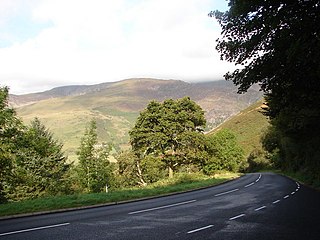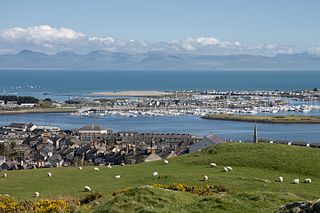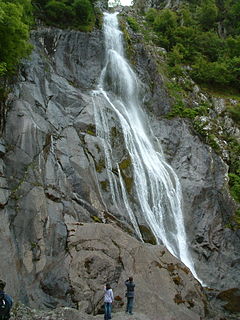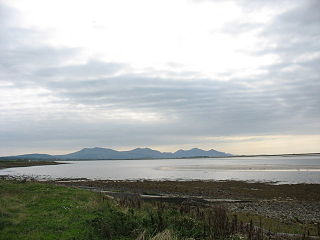Related Research Articles

Snowdonia is a mountainous region in northwestern Wales and a national park of 823 square miles (2,130 km2) in area. It was the first to be designated of the three national parks in Wales, in 1951.

Caernarfon is a royal town, community, and port in Gwynedd, Wales, with a population of 9,852. It lies along the A487 road, on the eastern shore of the Menai Strait, opposite the Isle of Anglesey. The city of Bangor is 8.6 miles (13.8 km) to the north-east, while Snowdonia fringes Caernarfon to the east and south-east. Carnarvon and Caernarvon are Anglicised spellings that were superseded in 1926 and 1974 respectively.

The Menai Strait is a narrow stretch of shallow tidal water about 25 km (16 mi) long, which separates the island of Anglesey from the mainland of Wales. It varies in width from 400 metres (1,300 ft) from Fort Belan to Abermenai Point to 1,100 metres (3,600 ft) from Traeth Gwyllt to Caernarfon Castle. It then narrows to 500 metres (1,600 ft) in the middle reaches and then it broadens again. At Bangor, Garth Pier, it is 900 metres (3,000 ft) wide. It then widens out, and the distance from Puffin Island to Penmaenmawr is about 8 kilometres (5.0 mi).

The A487, officially the Fishguard to Bangor Trunk Road, is a trunk road in Wales that follows the coast from Haverfordwest, Pembrokeshire, in the south, to Bangor, Gwynedd, in the north.

Pwllheli is a market town and community of the Llŷn Peninsula in Gwynedd, north-western Wales. It had a population of 4,076 in 2011 of whom a large proportion, 81%, are Welsh speaking. Pwllheli is the place where Plaid Cymru was founded. It is the birthplace of the Welsh poet Sir Albert Evans-Jones.

Abergwyngregyn is a village and community of historical note in Gwynedd, a county and principal area in Wales. Under its historic name of Aber Garth Celyn it was the seat of Llywelyn ap Gruffudd. It lies in the historic county of Caernarfonshire.
Templeborough is a suburb of Rotherham, South Yorkshire, England. The suburb falls within the Brinsworth and Catcliffe ward of Rotherham Metropolitan Borough Council. The area takes its name from the remains of the Roman fort found there which were mistakenly believed to be that of a Roman Temple.

Pennal is a village and community on the A493 road in southern Gwynedd, Wales, on the north bank of the Afon Dyfi/River Dovey, near Machynlleth.

Segontium is a Roman fort on the outskirts of Caernarfon in Gwynedd, North Wales. The fort, which survived until the end of the Roman occupation of Britain, was garrisoned by Roman auxiliaries from present-day Belgium and Germany. It was the most important military base and administrative centre in this part of Britain.

Sarn Helen refers to several stretches of Roman road in Wales. The 160-mile (260 km) route, which follows a meandering course through central Wales, connects Aberconwy in the north with Carmarthen in the west. Despite its length, academic debate continues as to the precise course of the Roman road. Many sections are now used by the modern road network while other parts are still traceable. However, there are sizeable stretches that have been lost and are unidentifiable.

Dinas Dinlle is a small settlement in Gwynedd, north-west Wales which is also, historically, part of Caernarfonshire.
Caernarvon railway station was a station on the former Bangor and Carnarvon Railway between Caernarfon, Gwynedd and Menai Suspension Bridge near Bangor. The station was closed to all traffic in January 1972. The station has since been demolished and the site redeveloped.

The Castles and Town Walls of King Edward in Gwynedd is a UNESCO-designated World Heritage Site located in Gwynedd, Wales. It includes the castles of Beaumaris and Harlech and the castles and town walls of Caernarfon and Conwy. UNESCO considers the sites to be the "finest examples of late 13th century and early 14th century military architecture in Europe".

The Roman era in the area of modern Wales began in 48 AD, with a military invasion by the imperial governor of Roman Britain. The conquest was completed by 78 AD, and Roman rule endured until the region was abandoned in 383 AD.

The Llŷn Coastal Path is a waymarked 146-kilometre (91 mi) long-distance footpath running along the coast of the Llŷn Peninsula from Caernarfon to Porthmadog in Gwynedd, north-west Wales. A large part of the Llŷn Peninsula is designated an Area of Outstanding Natural Beauty.

Caer Gai is a Grade II listed Roman fort in the district of Penllyn, Gwynedd, Wales, UK. It is located about 1 mile or 1.6 km north of the village of Llanuwchllyn, and the same distance west of Lake Bala.

Tomen y Mur is a First Century AD Roman fort in Snowdonia, Gwynedd, Wales. The fortification, which lies on the slope of an isolated spur northeast of Llyn Trawsfynydd, was constructed during the North Wales campaigns of governor Gnaeus Julius Agricola in AD 78. The fort stood adjacent to the Roman road known as Sarn Helen. It was occupied until it was abandoned around AD 140. In the 11th century, the Normans reused part of the site for a motte.

Y Foryd, also known as Foryd Bay, is a tidal bay in Gwynedd, Wales. It is located at the south-western end of the Menai Strait, about two miles south-west of Caernarfon. Several rivers flow into the bay and there are large areas of mudflats and salt marsh. A shingle spit partly blocks the mouth of the bay. At the north-western end is Fort Belan, built during the 18th century.

Caernarfon Castle – often anglicised as Carnarvon Castle or Caernarvon Castle – is a medieval fortress in Caernarfon, Gwynedd, north-west Wales cared for by Cadw, the Welsh Government's historic environment service. It was a motte-and-bailey castle from the late 11th century until 1283 when King Edward I of England began to replace it with the current stone structure. The Edwardian town and castle acted as the administrative centre of north Wales, and as a result the defences were built on a grand scale. There was a deliberate link with Caernarfon's Roman past, and the Roman fort of Segontium is nearby.
References
- Christopher Houlder, Wales: an Archaeological Guide (London, 1978)
- Lynch, Frances (1995) Gwynedd (A guide to ancient and historic Wales) (London: HMSO) ISBN 0-11-701574-1
- Roman Britain website
- Cpat.org